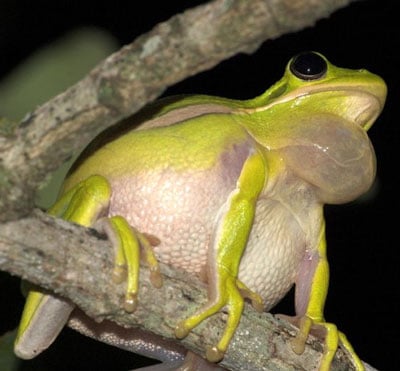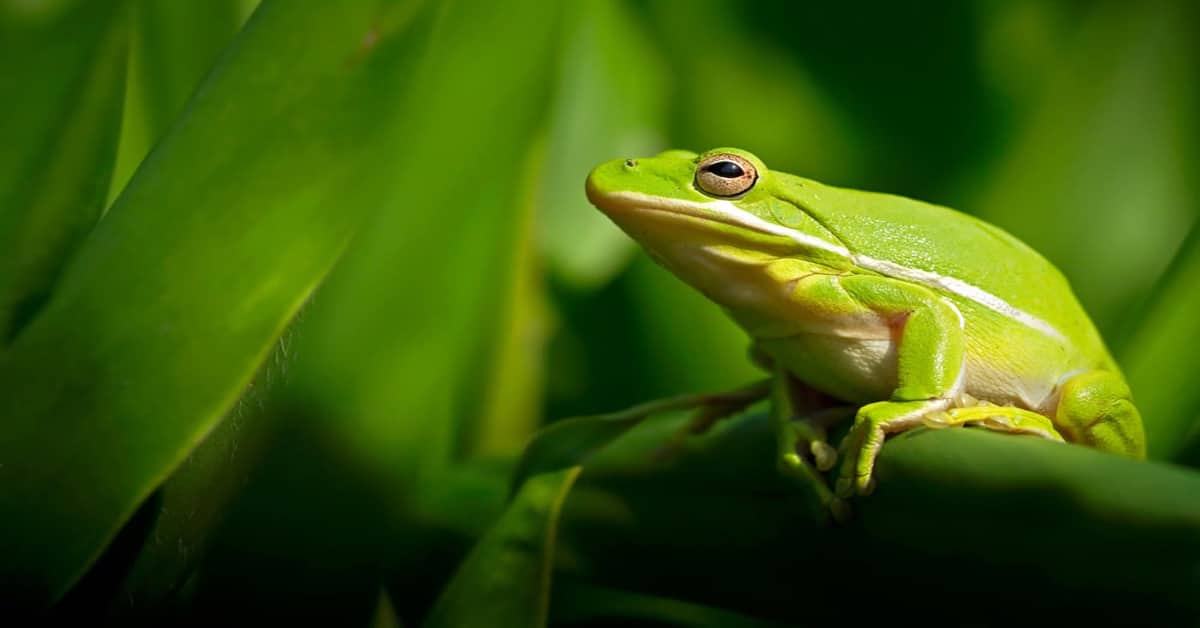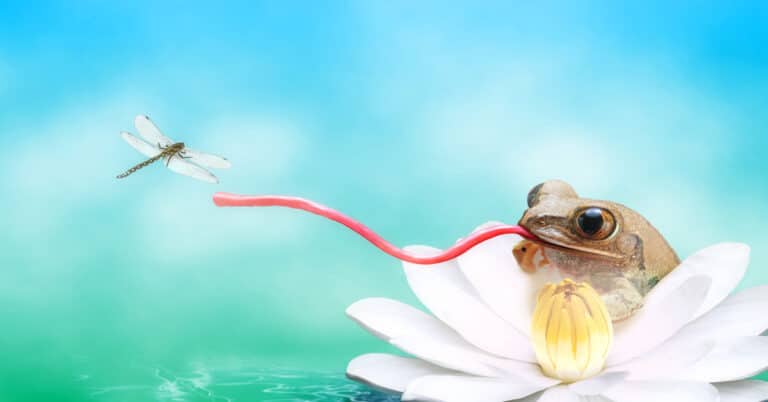Green Frog
Lithobates clamitans belong to the species of frogs. They are commonly known as Green frogs and usually belong to the Eastern half of Canada and the United States. The other subspecies of the green frog are the northern green frog and Bronze Frog Rana Clamitans.
Anatomy

Pacific Tree Frog

Green frogs are usually mid-sized. Their length varies from 5 to 10 cm and their body weight is about 28 – 85gm. The adult male frog is larger than adult female frogs. The tympanum of a male frog is double its eye diameter while in a female frog, the tympanum is the same as its eye diameter. Unlike bullfrogs, these species have prominent, glandular ridges and layered skin folds. They also have soft skin and dorsolateral ridges. They have long webbed feet and hind legs. Young frogs have a black spotted back. Their senses are finely developed.
Size
The size of these frogs ranges from 6cm to 9 cm.
Color
Like the bullfrogs, the color of these frogs is also brown, but these species have dorsolateral fold. The skin is finely granular and soft. Green frogs generally have mottling beneath their head and legs.
Sounds
The male green frogs have two vocal pouches. They usually call during the night and the day. They make a throaty sound like plucking banjo strings.
Their big bulging eye can see anywhere in any direction. They have a tympanum which is also called the eardrum, behind their eyes. This eardrum allows the frog to hear the voices of other creatures. This circular spot behind their eye vibrates to sounds, that are then conveyed to the brain of the frog.

Behavior
Adult frogs of this species, mostly stay in the water while the younger green frogs stay on the land as well when the soil and grass are moist. Green frogs are generally diurnal. However, their sound can be heard in hotter days and nights.
Habitat
You normally associate Green frogs with shallow freshwater lakes, ponds, ditches, brooks, swamps and streams. They can be frequently observed on the shores, resting and hunting for food. However, they immediately leap into the water when an intruder approaches them. They are Ecotone. While resting on the aquatic and terrestrial boundary, these green frogs can take a one long easy leap into the water and leaves behind their enemies. This species of green frog can also be seen in ditches and streams.
Reproduction

Species of green frogs mate either in permanent or in semi-permanent fresh water. Male frogs call from different territories, making a sound that resembles to banjo string playing at single note. Their mating season usually takes place between April and August.
Their mating takes place as Amplexus, when the male frog holds the female frog’s body behind her front legs with his front legs. In the end, the female releases the eggs. The male frog ejects its sperm. This sperms float to the egg and are then covered by an egg mass. The entire fertilization occurs in water. Every individual egg clutch can consist of 1000 -7000 eggs, which are attached to the vegetation submerged under water.
These green frogs are usually olive green in color, with the bottom layer of the abdomen, creamy white. A Metamorphosis takes place in the same season as that of mating. The male tadpoles become sexually active within 1 year, while female tadpoles take some time and become sexually mature in 2-3 years. Green frogs breed in fresh water bodies.
Food
Adult green frogs can eat any medium sized prey that can enter into their mouth easily. They forage for spiders, small insects, small snakes, snails, birds, fish, other frogs, crayfish and shrimps. The young tadpoles rely on water plants and algae.
These tadpoles mainly graze on diatoms and aquatic algae. The adult green frog shows an amazing characteristic of eating everything that passes by them, without really going after prey. Other than this they usually eat fish, frogs, insects, worms and occasionally tadpoles.
The American Green Tree Frog

Hyla Cinerea, or the Green American tree frog of the genus Hyla, is considered as part of the species that belong to the new world frogs. Its popularity as a pet (normally found in your backyards) has given it the prestigious title Georgia’s and Louisiana’s state amphibian. This medium-sized frog that grows up to 2.5 Inches or 6 Ceminteres long has a green color with varying shades of lime green and yellowish-olive, with the temperature and lighting playing an important part in the color variations. Sometimes white or gold patches can be seen on its skin, and you can further see pale white or yellow lines from its upper lips to the groin. Other distinguishing features include big toe pads and a smooth skin, with a pale white to yellow colored abdomen. Males are smaller than the females and have a unique vocal pouch with a wrinkled throat.
As A Pet
If you like to own unique pets then this frog specie is an ideal example.
Housing
- For 1 or 2 frogs an aquarium of 10 gallon capacity is sufficient. However, if you want to increase the number of number of frogs, then enlarge the size of the tank as well.
- To make your aquarium more suitable for their inhabitants, make sure that the substrate material is larger than they can ingest.
- Make sure that you cover the aquarium; otherwise the frog can escape.
- Keep the water depth in the aquarium shallow, about 3 to 4 inches.
- Sphagnum moss or soil is suitable.
- Make sure that your aquarium’s water dish is large if your frogs are adults. Make sure that you provide a large-enough water dish for the frogs to submerge. However, little tadpoles can survive in an aquarium filled with water.
- Decorate your aquarium with live or artificial plants and toys for their pleasure.
- Remember that, using fluorescent lights is a source of supplying nutrients to the frogs.
- A Temperature of 68 to 75 F should be maintained inside the aquarium. Room temperature is suitable for frogs though the temperature goes down during the night.
- Water inside the aquarium should be free from chlorine. Dechlorinated water is best suitable for frogs. Water filtration is not needed; however, it is required to change at least 50 % of water regularly. If it is not possible daily, then try to change at least two times in a week. Some experts feel that continuous water vibrations caused by the filter can be harmful for frogs.
Feeding
Feeding these cute little pets is not difficult. You can serve them earthworms, live crickets, small fishes and meal-worms. You can also sprinkle some vitamin powder on their food. These powders are easily available in your local pet shops. To start with, initially you can sever them 3-4 small crickets every day. However, few experts suggest feeding adult frogs on alternative days. These frogs usually enjoy variety in their food. So, you can make a diet which primarily consists of cricket and add some other supplemented items such as earthworm or some fishes. You must take care to gut- load the prey or food items with nutritional supplements.

Having discovered a fondness for insects while pursuing her degree in Biology, Randi Jones was quite bugged to know that people usually dismissed these little creatures as “creepy-crawlies”.







